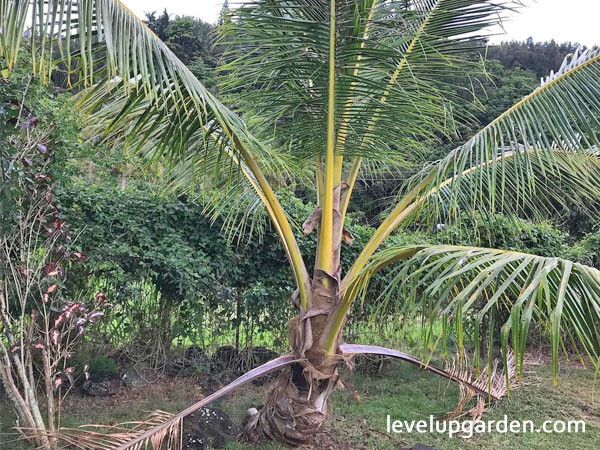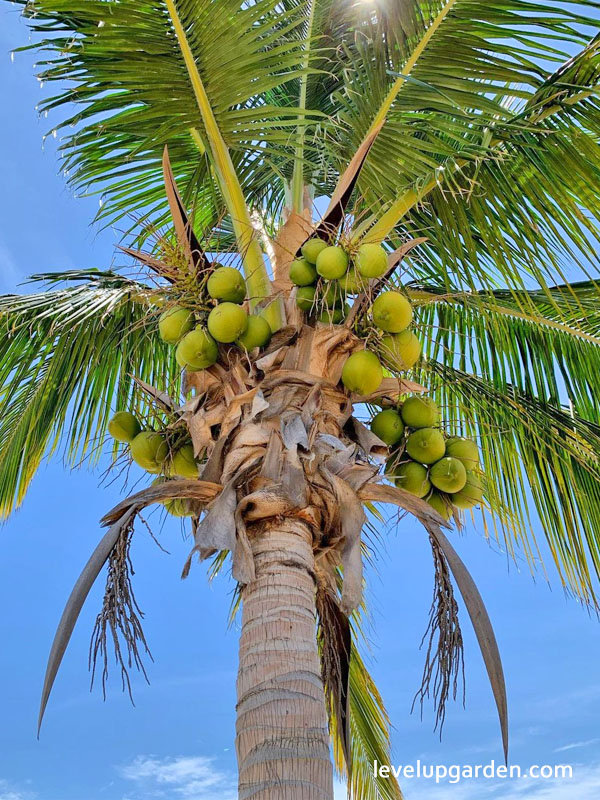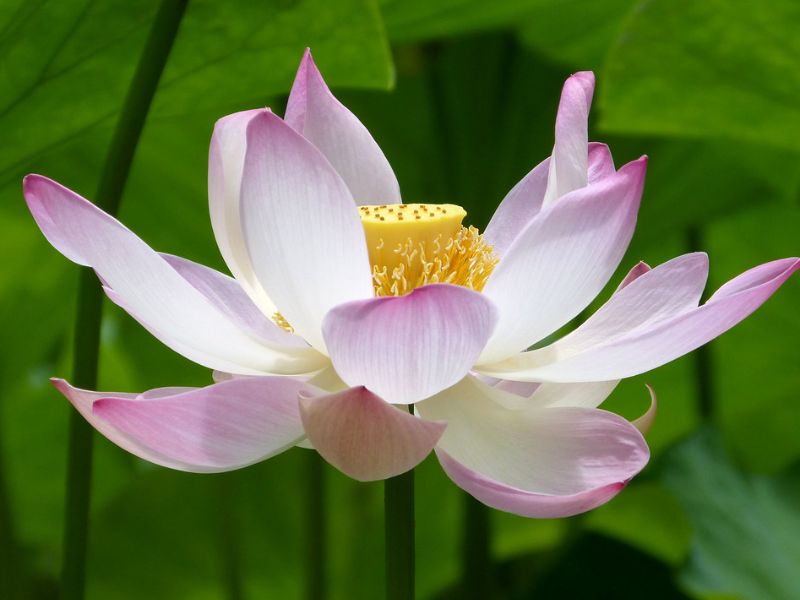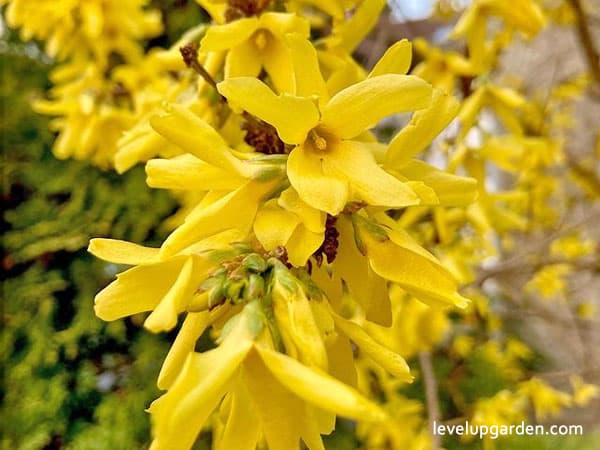Malayan Coconut Palm (Cocos nucifera, Green Malayan Coconut, Coconut Palm) is a member of the palm family and is believed to be native to the South Pacific. Green Malayan coconuts are known for their ability to withstand drought and salinity, but only after the tree is well-established. If exposed to a salty environment while the tree is still vigorous, both the leaves and roots will rapidly decline.

Green Malayan begins fruiting at about 2′- 3′ gray wood, while Malayan does not fruit until it is about 6′- 8′. Palm trees are easy to prune and therefore easy to care for. Even when the leaves die, they fall off the tree without any hassle. Malayan coconut trees are relatively low maintenance, and their resistance to wind, drought, and salt makes them ideal for coastal plantings.
I. Plant Profile – An Overview of the Coconut Palm Tree ‘Green Malayan’
| Common Name | Malayan Coconut Palm, Green Malayan Coconut, Coconut Palm |
| Botanical Name | Cocos nucifera ‘Malayan’ |
| Family | Arecaceae |
| Genus | Cocos |
| Species | nucifera |
| Origin | Malay Archipelago, South Pacific |
| Mature Width | 5-10 ft Indoors. 10-15 ft Outdoors |
| Sunlight | Full-Partial |
| Drought Tolerance | High |
| Zone | 10-12 |
| Salt Tolerance | High |
| Growth Rate | Moderate |
| Water | Requires consistently moist soil; do not let dry out between waterings |
| Sun Exposure | Full Sun |
| Foliage | Evergreen |
| Foliage Color | Dark Green, Light Green, Medium Green |
II. Coconut Palm Tree ‘Green Malayan’ Appearance
Green Malayan palms typically grow from 50 to 80 feet tall. After four to six years, the palms begin to flower and eventually bear fruit. Once fruiting begins, the coconut can yield 50 to 200 coconuts each year.

III. Coconut Palm Tree ‘Green Malayan’ Growing and Care Conditions
In addition to being one of the world’s most versatile food and fiber trees, coco palms are also beautiful landscape trees suited to frost-free climates. It is also ideal for planting in large patio planters on decks, patios, and poolside. This dwarf variety is especially well suited for growing indoors in full sun.
Planting
Cocos nucifera ‘Green Malaya’ can be planted below ground level to create a deep, low root base that will stabilize and hold fruit low for long periods of time. Green Malaya is more susceptible to strong winds than taller varieties because it does not form large shoots at the base of its trunk. Prepare the planting site (pit) well. Pits should be used with plenty of organic matter and mulch.
Light
Malayan Coconut Palm is best grown in full sun applying 6-8 hours of sun exposure everyday. It does not do well in the shade. Find a spot where it can receive adequate sunlight.
Watering
Newly planted palms should be watered immediately after planting to fully saturate the roots. Then, continue to water about 1 inch once a week, especially during the first 3-4 months.
Fertilizer
Good drainage and fertilization are important for good growth. Palm trees should be regularly fed with a good quality NPK fertilizer in the ratio 8N:1P:16K. NPK values are listed on all fertilizer packaging.
Soil Requirements
Sandy soil is generally preferred, but not a prerequisite if a good pit can be dug. In tropical regions, avoid planting during the height of the rainy season and keep the plants in the shade for the first few years. Protection from livestock may also be necessary. It is not necessary to bury the coconuts; just keep mulching and plenty of water.
Temperature
Like other coconut varieties, it can only be grown in areas where temperatures above 40 degrees Fahrenheit are maintained, and the genus will stop producing chlorophyll below that temperature.
Pruning
Pruning may be necessary to remove dead branches, to make the plant bushier, to allow it to flower, or to maintain a particular size or shape. Most mixtures can be freely pruned to maintain the desired size and shape.
Trimming foliage also tidies up the appearance of the plant. It also encourages more side shoots and flowers, and eliminates the need for a large root system. This is important because roots take up only limited space.
Many shrubs can be trimmed regularly to shape them as hedges, borders, or formal foundation plantings. When pruning plants for size and shape, make a slight diagonal cut just above the leaf bud. These buds will provide a place for new shoots to emerge.
Always use sharp, clean tools for pruning. A variety of tools can be used, depending on the task at hand. Hand scissors, pruning shears, and loppers are suitable for most shrubs. For larger mature shrubs and trees, pole pruners and tree saws are appropriate. Trees that are too large to be safely pruned with a pole pruner are best handled by a professional tree service.
Pests and Diseases
Nematodes can invade Green Mallee Palm. Yellowing disease, virus diseases, and fungi can infect palm trees. Be sure to select plant varieties that are resistant to yellowing disease. Ganoderma lucidum butt rot can infect the lower trunk and roots and kill palms. Avoid damaging palms in this area because there is no control method, only prevention.
IV. Uses of Coconut Palm Tree ‘Green Malayan’
The coco palm (Cocos nucifera) is arguably the best palm in the world because of its products and uses for people. On the other hand, the oil palm, a member of the date palm family, is less adaptable and plays an important role in small areas. While undoubtedly important, the oil palm, while highly adaptable, is far less useful than the coconut.

As a specimen tree, it is used to add a tropical character to the landscape. It can be grown in outdoor planters during the summer months and brought indoors in the winter. Gorgeous potted plants are recommended for large indoor areas with bright windows.
A beautiful street tree, the coco palm is also ideal as a backdrop, framing tree, or striking freestanding specimen tree. Coconut trees near street trees, sidewalks, and patios should be pruned to prevent flowers and fruit from falling. It gives the tropical feel.
Coconut oil is quite popular these days because of its unique and appealing flavor. It is used in many recipes as a substitute for butter. Compared to olive oil and canola oil, it has a higher content of saturated fatty acids, and there is some controversy about its health effects. However, the lauric acid in coconut oil is considered excellent for health because it can boost the immune system and protect against several diseases.
Coconut oil is not only used for cooking. It is also an excellent hair conditioner. Using coconut oil on hair can make dry hair soft and silky. In many parts of the world, it is very common to massage babies’ skin with coconut oil, which is good for the skin.
Coconut palm leaves are very large and beautiful. I love the way they look and they make great photographic subjects. People use these leaves to make fences and roofs for small huts, and many places still use them for thatch roofs. It is cost-effective and provides shelter for many people who cannot afford the cost of other materials.
They are also sometimes used for house walls as well as roofs. Building a house with palm fronds may not be the best choice, as they cannot withstand extreme climatic conditions and have safety issues, but in many places people are building shelters with these trees.
V. The Advantages of Coconut Palm Tree ‘Green Malayan’ for Your Garden
The large, fragrant coconut is one of the most popular varieties in the world. It also grows just as well outdoors as it does in containers, so even those living in northern countries can grow coconuts.

It can be placed outdoors during the warmer days and brought inside during the colder months. In time, you will have many large coconuts with soft, creamy pulp and rich coconut milk. Coconut trees begin to bear fruit when the gray skin grows two to three feet long.
The coconut-grown coconut tree will have a unique, tropical appearance when placed on top of a container. Eventually, it will grow into a mature palm with a large canopy filled with beautiful ring-shaped gray bark and leaves covered with bright green lobes.
Since it grows to fill the container in which it is planted, it is perfect for inside the house, on the balcony, or on the patio. It also grows indoors with no problem in low light. But wherever they are planted, coco palms are hardy, heat tolerant, drought tolerant, wind resistant, and low maintenance trees.
VI. FAQs
What is the Green Malayan Coconut tree?
Green Malayan Coconut can grow to 30 to 50 feet tall when mature. Tall varieties, on the other hand, can grow up to 80 feet when mature. Dwarf varieties will bear fruit in three years. With good care, they will bear fruit in 2.5 years.
Is Cocos nucifera an indoor plant?
If you want to go to sea, even if only in your mind, consider growing coconut palm (Cocos nucifera) indoors. However, there are some things to keep in mind. Unless you live in an area blessed with a natural environment, it is a rather fussy plant.
How long does it take to grow Cocos nucifera?
There are two varieties of coconut trees: tall and short. The dwarf variety matures and begins to bear fruit in 4-6 years, but they are not as hardy and easy to grow as the tall variety and often have a shorter life span.
How long does it take a dwarf coconut to bear fruit?
There are two varieties of coconut trees: tall and short. The dwarf variety matures and begins to bear fruit in 4-6 years, but they are not as hardy and easy to grow as the tall variety and often have a shorter life span.








523 responses to “Coconut Palm Tree ‘Green Malayan’”